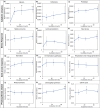Metabolic changes and biochemical degradation during dark anoxic incubation of Nannochloropsis: implications for low-energy microalgal cell rupture
- PMID: 40488754
- PMCID: PMC12234632
- DOI: 10.1007/s00449-025-03185-7
Metabolic changes and biochemical degradation during dark anoxic incubation of Nannochloropsis: implications for low-energy microalgal cell rupture
Abstract
Dark anoxic incubation has been identified as a low-cost method to facilitate the mechanical rupture of microalgae such as Nannochloropsis via autolysis-induced cell wall thinning. During this process, concentrated slurries of cells are incubated in the dark at an elevated temperature, to deprive them of light and oxygen. This work analyzed the integrity of proteins and lipids during dark anoxic incubation and investigated the cellular responses of Nannochloropsis through an in-depth proteomic analysis. Proteomic analysis identified enzymes associated with cellulose hydrolysis and glycolytic and fermentative pathways that are presumably activated to produce energy in the absence of light and oxygen. Progressive biochemical degradation was observed during 48 h of incubation, including the proteolysis and leakage of proteins, and the lipolysis and subsequent peroxidation of lipids. This provides further evidence of autolytic processes occurring during prolonged incubation, which can be attributed to uncontrolled action of intracellular proteases and lipases. Importantly, the resultant formation of peptides and free fatty acids will affect their use in food and fuel applications. It is therefore important to optimise the incubation time and parameters to achieve cell weakening while minimising the unnecessary degradation of biomacromolecules.
Keywords: Cell rupture; Dark anoxia; Lipolysis; Microalgae; Proteolysis.
© 2025. The Author(s).
Conflict of interest statement
Declarations. Ethics approval: This paper does not contain any studies with humans or animals. Conflict of interest: The authors declare no competing interests.
Figures






Similar articles
-
The Black Book of Psychotropic Dosing and Monitoring.Psychopharmacol Bull. 2024 Jul 8;54(3):8-59. Psychopharmacol Bull. 2024. PMID: 38993656 Free PMC article. Review.
-
Autistic Students' Experiences of Employment and Employability Support while Studying at a UK University.Autism Adulthood. 2025 Apr 3;7(2):212-222. doi: 10.1089/aut.2024.0112. eCollection 2025 Apr. Autism Adulthood. 2025. PMID: 40309023
-
Incentives for preventing smoking in children and adolescents.Cochrane Database Syst Rev. 2017 Jun 6;6(6):CD008645. doi: 10.1002/14651858.CD008645.pub3. Cochrane Database Syst Rev. 2017. PMID: 28585288 Free PMC article.
-
Novel application of metabolic imaging of early embryos using a light-sheet on-a-chip device: a proof-of-concept study.Hum Reprod. 2025 Jan 1;40(1):41-55. doi: 10.1093/humrep/deae249. Hum Reprod. 2025. PMID: 39521726 Free PMC article.
-
The use of Open Dialogue in Trauma Informed Care services for mental health consumers and their family networks: A scoping review.J Psychiatr Ment Health Nurs. 2024 Aug;31(4):681-698. doi: 10.1111/jpm.13023. Epub 2024 Jan 17. J Psychiatr Ment Health Nurs. 2024. PMID: 38230967
References
-
- Aguirre A-M, Bassi A, Saxena P (2013) Engineering challenges in biodiesel production from microalgae. Crit Rev Biotechnol 33(3):293–308 - PubMed
-
- Lee AK, Lewis DM, Ashman PJ (2012) Disruption of microalgal cells for the extraction of lipids for biofuels: processes and specific energy requirements. Biomass Bioenerg 46:89–101
-
- Spiden EM, Yap BHJ, Hill DRA, Kentish SE, Scales PJ, Martin GJO (2013) Quantitative evaluation of the ease of rupture of industrially promising microalgae by high pressure homogenization. Biores Technol 140:165–171 - PubMed
MeSH terms
Substances
LinkOut - more resources
Full Text Sources

